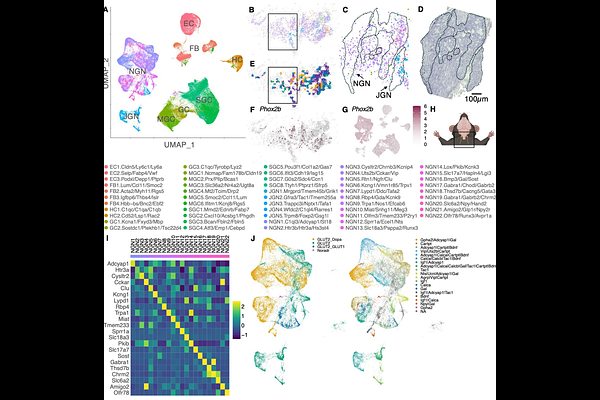NodoMap: a spatio-cellular map of the mouse nodose ganglia

NodoMap: a spatio-cellular map of the mouse nodose ganglia
Cheng, S.; Dowsett, G. K. C.; Rainbow, K.; Norton, M.; Roberts, A. G.; Phuah, P.; Bewick, G. A.; Lam, B. Y.; Yeo, G. S. H.; Murphy, K.
AbstractThe vagus nerve is a key component of the parasympathetic nervous system, innervating multiple abdominal organs to monitor and regulate their function. It forms the main neural pathway between the gastrointestinal tract and the brain, playing a major role in the regulation of energy homeostasis. The cell bodies for vagal sensory neurons reside in the nodose ganglia, with the left and right ganglia reported to have distinct roles in food intake and reward. Here, we have integrated our own single nucleus RNA sequencing data with multiple publicly available datasets to create a database of 108,482 nuclei and cells, and combined this with spatial transcriptomics to present a spatio-cellular transcriptional map of the mouse nodose ganglia, the \"NodoMap\". Nodose ganglia neuronal cells clustered into twenty-two different subtypes, all found in both left and right nodose ganglia, but with significant differences in gene expression between left and right ganglia across multiple neuronal subtypes. Overnight fasting modulated gene expression across specific neuronal subtypes, including nutrient responsive pathways. Spatial transcriptomics showed that while vagal neuronal types were highly interspersed, patterns of organisation into cellular neighbourhoods could be observed, with neighbourhoods identified of predominantly non-neuronal cells and of different neuronal populations accompanied by glial-like cells. Thus, NodoMap provides a detailed atlas of the mouse nodose ganglia in a spatial context, providing a platform for vagovagal neurocircuit analysis, and serving as an important resource to identify targets for pharmacotherapies for metabolic disease.